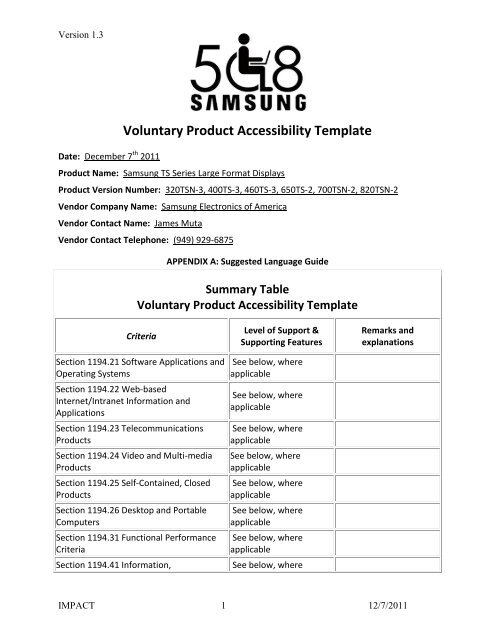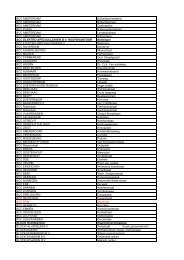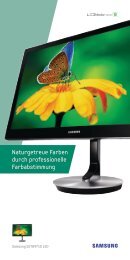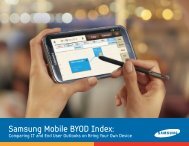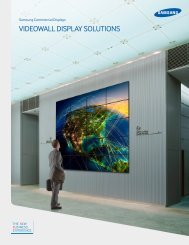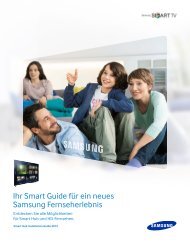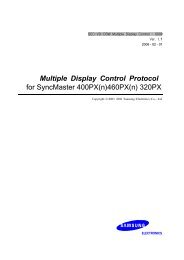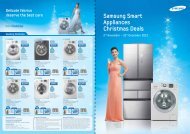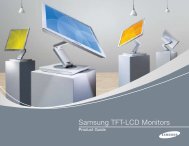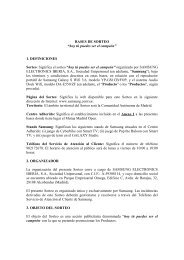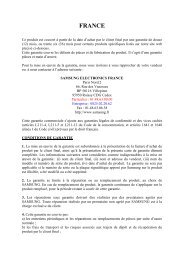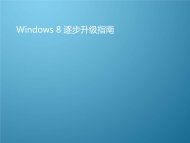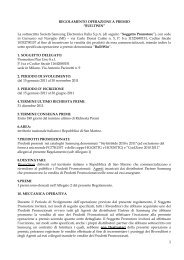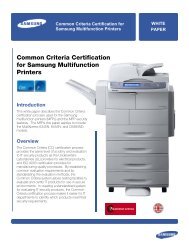Voluntary Product Accessibility Template - Samsung
Voluntary Product Accessibility Template - Samsung
Voluntary Product Accessibility Template - Samsung
Create successful ePaper yourself
Turn your PDF publications into a flip-book with our unique Google optimized e-Paper software.
Version 1.3<br />
Date: December 7 th 2011<br />
<strong>Voluntary</strong> <strong>Product</strong> <strong>Accessibility</strong> <strong>Template</strong><br />
<strong>Product</strong> Name: <strong>Samsung</strong> TS Series Large Format Displays<br />
<strong>Product</strong> Version Number: 320TSN-3, 400TS-3, 460TS-3, 650TS-2, 700TSN-2, 820TSN-2<br />
Vendor Company Name: <strong>Samsung</strong> Electronics of America<br />
Vendor Contact Name: James Muta<br />
Vendor Contact Telephone: (949) 929-6875<br />
APPENDIX A: Suggested Language Guide<br />
Summary Table<br />
<strong>Voluntary</strong> <strong>Product</strong> <strong>Accessibility</strong> <strong>Template</strong><br />
Criteria<br />
Section 1194.21 Software Applications and<br />
Operating Systems<br />
Section 1194.22 Web-based<br />
Internet/Intranet Information and<br />
Applications<br />
Section 1194.23 Telecommunications<br />
<strong>Product</strong>s<br />
Section 1194.24 Video and Multi-media<br />
<strong>Product</strong>s<br />
Section 1194.25 Self-Contained, Closed<br />
<strong>Product</strong>s<br />
Section 1194.26 Desktop and Portable<br />
Computers<br />
Section 1194.31 Functional Performance<br />
Criteria<br />
Section 1194.41 Information,<br />
Level of Support &<br />
Supporting Features<br />
See below, where<br />
applicable<br />
See below, where<br />
applicable<br />
See below, where<br />
applicable<br />
See below, where<br />
applicable<br />
See below, where<br />
applicable<br />
See below, where<br />
applicable<br />
See below, where<br />
applicable<br />
See below, where<br />
Remarks and<br />
explanations<br />
IMPACT 1 12/7/2011
Version 1.3<br />
Documentation and Support<br />
applicable<br />
Section 1194.21 Software Applications and Operating Systems -<br />
Detail<br />
<strong>Voluntary</strong> <strong>Product</strong> <strong>Accessibility</strong> <strong>Template</strong><br />
Criteria<br />
Level of Support &<br />
Supporting Features<br />
Remarks and<br />
explanations<br />
(a) When software is designed to run on a<br />
system that has a keyboard, product<br />
functions shall be executable from a<br />
keyboard where the function itself or the<br />
result of performing a function can be<br />
discerned textually.<br />
(b) Applications shall not disrupt or disable<br />
activated features of other products that<br />
are identified as accessibility features,<br />
where those features are developed and<br />
documented according to industry<br />
standards. Applications also shall not<br />
disrupt or disable activated features of any<br />
operating system that are identified as<br />
accessibility features where the application<br />
programming interface for those<br />
accessibility features has been<br />
documented by the manufacturer of the<br />
operating system and is available to the<br />
product developer.<br />
(c) A well-defined on-screen indication of<br />
the current focus shall be provided that<br />
moves among interactive interface<br />
elements as the input focus changes. The<br />
focus shall be programmatically exposed<br />
so that Assistive Technology can track<br />
focus and focus changes.<br />
(d) Sufficient information about a user<br />
interface element including the identity,<br />
operation and state of the element shall<br />
be available to Assistive Technology. When<br />
an image represents a program element,<br />
the information conveyed by the image<br />
MagicInfo software and a<br />
attached keyboard will allow<br />
textual information about the<br />
adjustment to the display<br />
setup , and client s/w<br />
On-Screen Display (OSD) utility<br />
or <strong>Samsung</strong>s digital signage<br />
MagicInfo application will not<br />
interfere with Microsoft<br />
Windows accessibility<br />
features.<br />
N/A – Displays image from<br />
device to which it is attached<br />
N/A – Displays image from<br />
device to which it is attached<br />
Magicinfor s/w is a digital<br />
signage solution, however, a<br />
keyboard can be connected to<br />
the monitor and control the<br />
displays application, displaying<br />
textual information of the<br />
necessary adjustment<br />
MagicInfo or the displays OSD<br />
will not affect features of<br />
other products that are<br />
identified as accessibility<br />
features .<br />
Displays image form attached<br />
system<br />
Displays image form attached<br />
system<br />
IMPACT 2 12/7/2011
Version 1.3<br />
must also be available in text.<br />
(e) When bitmap images are used to<br />
identify controls, status indicators, or<br />
other programmatic elements, the<br />
meaning assigned to those images shall be<br />
consistent throughout an application's<br />
performance.<br />
(f) Textual information shall be provided<br />
through operating system functions for<br />
displaying text. The minimum information<br />
that shall be made available is text<br />
content, text input caret location, and text<br />
attributes.<br />
(g) Applications shall not override user<br />
selected contrast and color selections and<br />
other individual display attributes.<br />
(h) When animation is displayed, the<br />
information shall be displayable in at least<br />
one non-animated presentation mode at<br />
the option of the user.<br />
(i) Color coding shall not be used as the<br />
only means of conveying information,<br />
indicating an action, prompting a<br />
response, or distinguishing a visual<br />
element.<br />
(j) When a product permits a user to adjust<br />
color and contrast settings, a variety of<br />
color selections capable of producing a<br />
range of contrast levels shall be provided.<br />
(k) Software shall not use flashing or<br />
blinking text, objects, or other elements<br />
having a flash or blink frequency greater<br />
than 2 Hz and lower than 55 Hz.<br />
(l) When electronic forms are used, the<br />
form shall allow people using Assistive<br />
Technology to access the information, field<br />
elements, and functionality required for<br />
The icons that identify the<br />
meanings of function in the<br />
On-Screen Display (OSD) are<br />
consistent and are matched to<br />
descriptive text.<br />
N/A – Displays image from<br />
device to which it is attached<br />
The displays OSD is<br />
independent of any<br />
application and controlled by<br />
the end user<br />
On-Screen Display (OSD) utility<br />
does not use any animation.<br />
On-Screen Display (OSD) utility<br />
does not use color coding to<br />
convey information, actions,<br />
prompting responses or<br />
distinguishing visual elements.<br />
On-Screen Display (OSD) utility<br />
allows user selection of color<br />
and contrast.<br />
N/A<br />
N/A<br />
Displays image form attached<br />
system<br />
The end user has complete<br />
control over the display<br />
attributes through the On<br />
Screen Display (OSD)<br />
Current On-Screen Display<br />
(OSD) selection is identified by<br />
changing icon by moving from<br />
dark text to light text for the<br />
selected function. Sub-menus<br />
do include bar-graphs and<br />
numeric values where<br />
necessary. Additional text is<br />
provided to navigate physical<br />
OSD buttons.<br />
Monitor display does not use<br />
a flashing cursor or text and<br />
does not interfere with the<br />
preferences for the computer<br />
system.<br />
On-screen display (OSD) utility<br />
does not have electronic forms<br />
IMPACT 3 12/7/2011
Version 1.3<br />
completion and submission of the form,<br />
including all directions and cues.<br />
IMPACT 4 12/7/2011
Version 1.3<br />
Section 1194.22 Web-based Internet/Intranet information and<br />
applications - Detail<br />
<strong>Voluntary</strong> <strong>Product</strong> <strong>Accessibility</strong> <strong>Template</strong><br />
Criteria<br />
Level of Support &<br />
Supporting Features<br />
Remarks and<br />
explanations<br />
(a) A text equivalent for every non-text<br />
element shall be provided (e.g., via<br />
"alt", "longdesc", or in element<br />
content).<br />
(b) Equivalent alternatives for any<br />
multimedia presentation shall be<br />
synchronized with the presentation.<br />
(c) Web pages shall be designed so<br />
that all information conveyed with<br />
color is also available without color, for<br />
example from context or markup.<br />
(d) Documents shall be organized so<br />
they are readable without requiring an<br />
associated style sheet.<br />
(e) Redundant text links shall be<br />
provided for each active region of a<br />
server-side image map.<br />
(f) Client-side image maps shall be<br />
provided instead of server-side image<br />
maps except where the regions cannot<br />
be defined with an available geometric<br />
shape.<br />
(g) Row and column headers shall be<br />
identified for data tables.<br />
(h) Markup shall be used to associate<br />
data cells and header cells for data<br />
tables that have two or more logical<br />
When using MagicInfi-I<br />
application there is a text<br />
equivalent for ever<br />
element used<br />
N/A<br />
N/A<br />
N/A<br />
N/A<br />
N/A<br />
N/A<br />
N/A<br />
MagicInfo-I is <strong>Samsung</strong>s<br />
internet controlled digital<br />
signage application<br />
MagicInfo-I is a digital<br />
signage application for<br />
advertising not presenting<br />
MagicInfo-I does not<br />
create web pages<br />
MagicInfo-I is a digital<br />
signage application for<br />
advertising not presenting<br />
MagicInfo-I is a digital<br />
signage application for<br />
advertising and does not<br />
create web pages or image<br />
maps<br />
MagicInfo-I is a digital<br />
signage application for<br />
advertising and does not<br />
create web pages or image<br />
maps<br />
MagicInfo-I is a digital<br />
signage application for<br />
advertising and does not<br />
create web pages<br />
MagicInfo-I is a digital<br />
signage application for<br />
advertising and does not<br />
IMPACT 5 12/7/2011
Version 1.3<br />
levels of row or column headers.<br />
(i) Frames shall be titled with text that<br />
facilitates frame identification and<br />
navigation<br />
(j) Pages shall be designed to avoid<br />
causing the screen to flicker with a<br />
frequency greater than 2 Hz and lower<br />
than 55 Hz.<br />
N/A<br />
N/A<br />
create web pages<br />
MagicInfo-I is a digital<br />
signage application for<br />
advertising and does not<br />
create web pages<br />
MagicInfo-I is a digital<br />
signage application for<br />
advertising and does not<br />
create web pages<br />
(k) A text-only page, with equivalent<br />
information or functionality, shall be<br />
provided to make a web site comply<br />
with the provisions of this part, when<br />
compliance cannot be accomplished in<br />
any other way. The content of the textonly<br />
page shall be updated whenever<br />
the primary page changes.<br />
(l) When pages utilize scripting<br />
languages to display content, or to<br />
create interface elements, the<br />
information provided by the script<br />
shall be identified with functional text<br />
that can be read by Assistive<br />
Technology.<br />
(m) When a web page requires that an<br />
applet, plug-in or other application be<br />
present on the client system to<br />
interpret page content, the page must<br />
provide a link to a plug-in or applet<br />
that complies with 1194.21(a) through<br />
(l).<br />
(n) When electronic forms are<br />
designed to be completed on-line, the<br />
form shall allow people using Assistive<br />
Technology to access the information,<br />
field elements, and functionality<br />
required for completion and<br />
submission of the form, including all<br />
directions and cues.<br />
N/A<br />
N/A<br />
N/A<br />
N/A<br />
MagicInfo-I is a digital<br />
signage application for<br />
advertising<br />
MagicInfo-I is a digital<br />
signage application for<br />
advertising and does not<br />
create web pages<br />
MagicInfo-I is a digital<br />
signage application for<br />
advertising and does not<br />
create web pages<br />
MagicInfo-I is a digital<br />
signage application for<br />
advertising and does not<br />
create web pages or<br />
electronic forms<br />
(o) A method shall be provided that N/A MagicInfo-I is a digital<br />
IMPACT 6 12/7/2011
Version 1.3<br />
permits users to skip repetitive<br />
navigation links.<br />
(p) When a timed response is required,<br />
the user shall be alerted and given<br />
sufficient time to indicate more time is<br />
required.<br />
N/A<br />
signage application for<br />
advertising and does not<br />
create web pages<br />
MagicInfo-I is a digital<br />
signage application for<br />
advertising and does not<br />
create web pages or have<br />
timed responces<br />
Section 1194.23 Telecommunications <strong>Product</strong>s - Detail<br />
<strong>Voluntary</strong> <strong>Product</strong> <strong>Accessibility</strong> <strong>Template</strong><br />
Criteria<br />
(a) Telecommunications products or<br />
systems which provide a function<br />
allowing voice communication and<br />
which do not themselves provide a<br />
TTY functionality shall provide a<br />
standard non-acoustic connection<br />
point for TTYs. Microphones shall be<br />
capable of being turned on and off to<br />
allow the user to intermix speech<br />
with TTY use.<br />
(b) Telecommunications products<br />
which include voice communication<br />
functionality shall support all<br />
commonly used cross-manufacturer<br />
non-proprietary standard TTY signal<br />
protocols.<br />
(c) Voice mail, auto-attendant, and<br />
interactive voice response<br />
telecommunications systems shall be<br />
usable by TTY users with their TTYs.<br />
(d) Voice mail, messaging, autoattendant,<br />
and interactive voice<br />
N/A<br />
N/A<br />
N/A<br />
N/A<br />
Level of Support &<br />
Supporting Features<br />
Remarks and<br />
explanations<br />
Not applicable as a Telecom<br />
product.<br />
Not applicable as a Telecom<br />
product.<br />
Not applicable as a Telecom<br />
product.<br />
Not applicable as a Telecom<br />
product.<br />
IMPACT 7 12/7/2011
Version 1.3<br />
response telecommunications<br />
systems that require a response from<br />
a user within a time interval, shall give<br />
an alert when the time interval is<br />
about to run out, and shall provide<br />
sufficient time for the user to indicate<br />
more time is required.<br />
(e) Where provided, caller<br />
identification and similar<br />
telecommunications functions shall<br />
also be available for users of TTYs,<br />
and for users who cannot see<br />
displays.<br />
(f) For transmitted voice signals,<br />
telecommunications products shall<br />
provide a gain adjustable up to a<br />
minimum of 20 dB. For incremental<br />
volume control, at least one<br />
intermediate step of 12 dB of gain<br />
shall be provided.<br />
(g) If the telecommunications product<br />
allows a user to adjust the receive<br />
volume, a function shall be provided<br />
to automatically reset the volume to<br />
the default level after every use.<br />
(h) Where a telecommunications<br />
product delivers output by an audio<br />
transducer which is normally held up<br />
to the ear, a means for effective<br />
magnetic wireless coupling to hearing<br />
technologies shall be provided.<br />
(i) Interference to hearing<br />
technologies (including hearing aids,<br />
cochlear implants, and assistive<br />
listening devices) shall be reduced to<br />
the lowest possible level that allows a<br />
user of hearing technologies to utilize<br />
the telecommunications product.<br />
(j) <strong>Product</strong>s that transmit or conduct<br />
information or communication, shall<br />
pass through cross-manufacturer,<br />
N/A<br />
N/A<br />
N/A<br />
N/A<br />
N/A<br />
N/A<br />
Not applicable as a Telecom<br />
product.<br />
Not applicable as a Telecom<br />
product.<br />
Not applicable as a Telecom<br />
product.<br />
Not applicable as a Telecom<br />
product.<br />
Not applicable as a Telecom<br />
product.<br />
Not applicable as a Telecom<br />
product.<br />
IMPACT 8 12/7/2011
Version 1.3<br />
non-proprietary, industry-standard<br />
codes, translation protocols, formats<br />
or other information necessary to<br />
provide the information or<br />
communication in a usable format.<br />
Technologies which use encoding,<br />
signal compression, format<br />
transformation, or similar techniques<br />
shall not remove information needed<br />
for access or shall restore it upon<br />
delivery.<br />
(k)(1) <strong>Product</strong>s which have<br />
mechanically operated controls or<br />
keys shall comply with the following:<br />
Controls and Keys shall be tactilely<br />
discernible without activating the<br />
controls or keys.<br />
(k)(2) <strong>Product</strong>s which have<br />
mechanically operated controls or<br />
keys shall comply with the following:<br />
Controls and Keys shall be operable<br />
with one hand and shall not require<br />
tight grasping, pinching, twisting of<br />
the wrist. The force required to<br />
activate controls and keys shall be 5<br />
lbs. (22.2N) maximum.<br />
(k)(3) <strong>Product</strong>s which have<br />
mechanically operated controls or<br />
keys shall comply with the following:<br />
If key repeat is supported, the delay<br />
before repeat shall be adjustable to at<br />
least 2 seconds. Key repeat rate shall<br />
be adjustable to 2 seconds per<br />
character.<br />
(k)(4) <strong>Product</strong>s which have<br />
mechanically operated controls or<br />
keys shall comply with the following:<br />
The status of all locking or toggle<br />
controls or keys shall be visually<br />
discernible, and discernible either<br />
through touch or sound.<br />
Controls and Keys are<br />
tactilely discernible<br />
without activating the<br />
controls or keys.<br />
Controls and Keys are<br />
operable with one hand<br />
and do not require tight<br />
grasping, pinching,<br />
twisting of the wrist. The<br />
force required to activate<br />
controls and keys is less<br />
than 5 lbs. (22.2N).<br />
<strong>Product</strong> does not support<br />
key repeat.<br />
<strong>Product</strong> does not have<br />
any locking or toggle<br />
controls.<br />
Not applicable as a Telecom<br />
product, but product does<br />
comply for 1194.26.<br />
Not applicable as a<br />
Telecom product, but<br />
product does comply for<br />
1194.26.<br />
Not applicable as a Telecom<br />
product, but product does<br />
comply for 1194.26.<br />
Not applicable as a<br />
Telecom product, but<br />
product does comply for<br />
1194.26.<br />
IMPACT 9 12/7/2011
Version 1.3<br />
IMPACT 10 12/7/2011
Version 1.3<br />
Section 1194.24 Video and Multi-media <strong>Product</strong>s – Detail<br />
<strong>Voluntary</strong> <strong>Product</strong> <strong>Accessibility</strong> <strong>Template</strong><br />
Criteria<br />
Level of Support &<br />
Supporting Features<br />
Remarks and<br />
explanations<br />
a) All analog television displays 13<br />
inches and larger, and computer<br />
equipment that includes analog<br />
television receiver or display circuitry,<br />
shall be equipped with caption<br />
decoder circuitry which appropriately<br />
receives, decodes, and displays closed<br />
captions from broadcast, cable,<br />
videotape, and DVD signals. As soon<br />
as practicable, but not later than July<br />
1, 2002, widescreen digital television<br />
(DTV) displays measuring at least 7.8<br />
inches vertically, DTV sets with<br />
conventional displays measuring at<br />
least 13 inches vertically, and standalone<br />
DTV tuners, whether or not<br />
they are marketed with display<br />
screens, and computer equipment<br />
that includes DTV receiver or display<br />
circuitry, shall be equipped with<br />
caption decoder circuitry which<br />
appropriately receives, decodes, and<br />
displays closed captions from<br />
broadcast, cable, videotape, and DVD<br />
signals.<br />
(b) Television tuners, including tuner<br />
cards for use in computers, shall be<br />
equipped with secondary audio<br />
program playback circuitry.<br />
(c) All training and informational<br />
video and multimedia productions<br />
<strong>Samsung</strong>s large screen<br />
display that include a DTV<br />
receiver includes a<br />
caption decoder and will<br />
display closed caption<br />
information if available<br />
from the video device.<br />
<strong>Samsung</strong>s large screen<br />
display that include a DTV<br />
receiver(TV tuner)includes<br />
a caption decoder and will<br />
display closed caption<br />
information if available<br />
from the video device.<br />
N/A<br />
N/A<br />
IMPACT 11 12/7/2011
Version 1.3<br />
which support the agency's mission,<br />
regardless of format, that contain<br />
speech or other audio information<br />
necessary for the comprehension of<br />
the content, shall be open or closed<br />
captioned.<br />
(d) All training and informational<br />
video and multimedia productions<br />
which support the agency's mission,<br />
regardless of format, that contain<br />
visual information necessary for the<br />
comprehension of the content, shall<br />
be audio described.<br />
(e) Display or presentation of<br />
alternate text presentation or audio<br />
descriptions shall be user-selectable<br />
unless permanent.<br />
N/A<br />
closed caption option is<br />
user selectable<br />
N/A<br />
The user can select the<br />
closed caption option<br />
through the display OSD<br />
IMPACT 12 12/7/2011
Version 1.3<br />
Section 1194.25 Self-Contained, Closed <strong>Product</strong>s – Detail<br />
<strong>Voluntary</strong> <strong>Product</strong> <strong>Accessibility</strong> <strong>Template</strong><br />
Criteria<br />
Level of Support &<br />
Supporting Features<br />
Remarks and<br />
explanations<br />
(a) Self contained products shall be<br />
usable by people with disabilities<br />
without requiring an end-user to<br />
attach Assistive Technology to the<br />
product. Personal headsets for<br />
private listening are not Assistive<br />
Technology.<br />
(b) When a timed response is<br />
required, the user shall be alerted<br />
and given sufficient time to indicate<br />
more time is required.<br />
(c) Where a product utilizes<br />
touchscreens or contact-sensitive<br />
controls, an input method shall be<br />
provided that complies with 1194.23<br />
(k) (1) through (4).<br />
(d) When biometric forms of user<br />
identification or control are used, an<br />
alternative form of identification or<br />
activation, which does not require<br />
the user to possess particular<br />
biological characteristics, shall also be<br />
provided.<br />
(e) When products provide auditory<br />
output, the audio signal shall be<br />
provided at a standard signal level<br />
through an industry standard<br />
connector that will allow for private<br />
listening. The product must provide<br />
the ability to interrupt, pause, and<br />
restart the audio at anytime.<br />
N/A<br />
N/A<br />
<strong>Samsung</strong> TSN models<br />
include a touch screen<br />
and complies with<br />
1194.23 section K 1~4<br />
N/A<br />
<strong>Samsung</strong>s LFD displays<br />
include integrated<br />
speakers and provide an<br />
industry standard output<br />
connection with ability to<br />
mute the audio. Note<br />
pause, and restart the<br />
audio is a function of the<br />
player not the display.<br />
N/A<br />
N/A<br />
<strong>Samsung</strong> TSN models<br />
include a touch screen<br />
control<br />
N/A<br />
<strong>Samsung</strong>s LFD displays<br />
include integrated speakers<br />
and provide an industry<br />
standard output connection<br />
with ability to mute the<br />
audio.<br />
IMPACT 13 12/7/2011
Version 1.3<br />
(f) When products deliver voice<br />
output in a public area, incremental<br />
volume control shall be provided with<br />
output amplification up to a level of<br />
at least 65 dB. Where the ambient<br />
noise level of the environment is<br />
above 45 dB, a volume gain of at least<br />
20 dB above the ambient level shall<br />
be user selectable. A function shall be<br />
provided to automatically reset the<br />
volume to the default level after<br />
every use.<br />
(g) Color coding shall not be used as<br />
the only means of conveying<br />
information, indicating an action,<br />
prompting a response, or<br />
distinguishing a visual element.<br />
(h) When a product permits a user to<br />
adjust color and contrast settings, a<br />
range of color selections capable of<br />
producing a variety of contrast levels<br />
shall be provided.<br />
(i) <strong>Product</strong>s shall be designed to avoid<br />
causing the screen to flicker with a<br />
frequency greater than 2 Hz and<br />
lower than 55 Hz.<br />
(j) (1) <strong>Product</strong>s which are<br />
freestanding, non-portable, and<br />
intended to be used in one location<br />
and which have operable controls<br />
shall comply with the following: The<br />
position of any operable control shall<br />
be determined with respect to a<br />
vertical plane, which is 48 inches in<br />
length, centered on the operable<br />
control, and at the maximum<br />
protrusion of the product within the<br />
48 inch length on products which are<br />
freestanding, non-portable, and<br />
intended to be used in one location<br />
and which have operable controls.<br />
The display internal audio<br />
amplifier maximum<br />
output is 10watts and can<br />
be reset to a default value<br />
N/A<br />
The monitors OSD<br />
provides a selectable<br />
range for contrast,<br />
individual color (R,G,B)<br />
and color temperature<br />
settings.<br />
N/A<br />
N/A<br />
N/A<br />
The monitor OSD provides a<br />
verity of display control<br />
features.<br />
N/A<br />
N/A<br />
IMPACT 14 12/7/2011
Version 1.3<br />
(j)(2) <strong>Product</strong>s which are<br />
freestanding, non-portable, and<br />
intended to be used in one location<br />
and which have operable controls<br />
shall comply with the following:<br />
Where any operable control is 10<br />
inches or less behind the reference<br />
plane, the height shall be 54 inches<br />
maximum and 15 inches minimum<br />
above the floor.<br />
(j)(3) <strong>Product</strong>s which are<br />
freestanding, non-portable, and<br />
intended to be used in one location<br />
and which have operable controls<br />
shall comply with the following:<br />
Where any operable control is more<br />
than 10 inches and not more than 24<br />
inches behind the reference plane,<br />
the height shall be 46 inches<br />
maximum and 15 inches minimum<br />
above the floor.<br />
(j)(4) <strong>Product</strong>s which are<br />
freestanding, non-portable, and<br />
intended to be used in one location<br />
and which have operable controls<br />
shall comply with the following:<br />
Operable controls shall not be more<br />
than 24 inches behind the reference<br />
plane.<br />
N/A<br />
N/A<br />
N/A<br />
N/A<br />
N/A<br />
N/A<br />
IMPACT 15 12/7/2011
Version 1.3<br />
Section 1194.26 Desktop and Portable Computers<br />
Criteria<br />
(a) All mechanically operated<br />
controls and keys shall comply with<br />
1194.23 (k) (1) through (4).<br />
(b) If a product utilizes touchscreens<br />
or touch-operated controls, an input<br />
method shall be provided that<br />
complies with 1194.23 (k) (1)<br />
through (4).<br />
(c) When biometric forms of user<br />
identification or control are used, an<br />
alternative form of identification or<br />
activation, which does not require<br />
the user to possess particular<br />
biological characteristics, shall also<br />
be provided.<br />
(d) Where provided, at least one of<br />
each type of expansion slots, ports<br />
and connectors shall comply with<br />
publicly available industry standards<br />
Level of Support &<br />
Supporting Features<br />
Controls and keys comply<br />
with 1194.23 (k) (1)<br />
through (4)<br />
<strong>Samsung</strong> TSN models<br />
include a touch screen<br />
and complies with<br />
1194.23 section K 1~4<br />
N/A<br />
N/A<br />
Remarks and<br />
explanations<br />
<strong>Product</strong> has tactile<br />
control buttons<br />
<strong>Samsung</strong> TSN models<br />
include a touch screen<br />
control<br />
N/A<br />
N/A<br />
IMPACT 16 12/7/2011
Version 1.3<br />
Section 1194.31 Functional Performance Criteria – Detail<br />
<strong>Voluntary</strong> <strong>Product</strong> <strong>Accessibility</strong> <strong>Template</strong><br />
Criteria<br />
Level of Support &<br />
Supporting Features<br />
Remarks and<br />
explanations<br />
(a) At least one mode of operation<br />
and information retrieval that does<br />
not require user vision shall be<br />
provided, or support for Assistive<br />
Technology used by people who are<br />
blind or visually impaired shall be<br />
provided.<br />
(b) At least one mode of operation<br />
and information retrieval that does<br />
not require visual acuity greater than<br />
20/70 shall be provided in audio and<br />
enlarged print output working<br />
together or independently, or support<br />
for Assistive Technology used by<br />
people who are visually impaired shall<br />
be provided.<br />
(c) At least one mode of operation<br />
and information retrieval that does<br />
not require user hearing shall be<br />
provided, or support for Assistive<br />
Technology used by people who are<br />
deaf or hard of hearing shall be<br />
provided<br />
(d) Where audio information is<br />
important for the use of a product, at<br />
least one mode of operation and<br />
information retrieval shall be provided<br />
in an enhanced auditory fashion, or<br />
support for assistive hearing devices<br />
shall be provided.<br />
(e) At least one mode of operation<br />
and information retrieval that does<br />
not require user speech shall be<br />
provided, or support for Assistive<br />
N/A<br />
N/A<br />
N/A<br />
<strong>Samsung</strong> monitors do not<br />
require user hearing.<br />
N/A<br />
N/A<br />
N/A<br />
N/A<br />
N/A<br />
N/A<br />
IMPACT 17 12/7/2011
Version 1.3<br />
Technology used by people with<br />
disabilities shall be provided.<br />
(f) At least one mode of operation and<br />
information retrieval that does not<br />
require fine motor control or<br />
simultaneous actions and that is<br />
operable with limited reach and<br />
strength shall be provided.<br />
<strong>Samsung</strong> LFD’s come with<br />
a remote control allowing<br />
easy access to the displays<br />
control<br />
<strong>Samsung</strong> LFD’s come with a<br />
remote control<br />
Section 1194.41 Information, Documentation and Support – Detail<br />
<strong>Voluntary</strong> <strong>Product</strong> <strong>Accessibility</strong> <strong>Template</strong><br />
Criteria<br />
(a) <strong>Product</strong> support documentation<br />
provided to end-users shall be made<br />
available in alternate formats upon<br />
request, at no additional charge<br />
(b) End-users shall have access to a<br />
description of the accessibility and<br />
compatibility features of products in<br />
alternate formats or alternate<br />
methods upon request, at no<br />
additional charge.<br />
(c) Support services for products shall<br />
accommodate the communication<br />
needs of end-users with disabilities.<br />
Level of Support &<br />
Supporting Features<br />
<strong>Product</strong> documentation is<br />
available in electronic form<br />
from the web samsung.com in<br />
a manner that can be access<br />
through many Assistive<br />
Technologies<br />
Description of accessible<br />
features is available in<br />
electronic form. And can be<br />
accessed from <strong>Samsung</strong>.com<br />
Email and toll-free telephone<br />
support is available 9am to<br />
9pm (EST)<br />
Remarks and explanations<br />
IMPACT 18 12/7/2011
Version 1.3<br />
APPENDIX A (of the DoS GPAT Checklist)<br />
Suggested Language for Filling out the GPAT<br />
In order to simplify the task of conducting market research assessments for procurement officials or customers,<br />
ITIC (Information Technology Industry Council) has developed suggested language for use when filling out a V<br />
PAT/G PAT. You may choose to employ all or some of the language below. Once you determine what language you<br />
intend to use, we recommend that use is consistent throughout all of your GPATs.<br />
Supporting Features (Column 2 on G PAT)<br />
Supports<br />
Use this language when you determine the product fully meets the letter and intent of the Criteria.<br />
Supports with Exceptions<br />
Use this language when you determine the product does not fully meet the letter and intent of the Criteria, but<br />
provides some level of access relative to the Criteria.<br />
Supports through Equivalent Facilitation<br />
Use this language when you have identified an alternate way to meet the intent of the Criteria or when the<br />
product does not fully meet the intent of the Criteria.<br />
Supports when combined with Compatible AT<br />
Use this language when you determine the product fully meets the letter and intent of the Criteria when used in<br />
combination with Compatible AT. For example, many software programs can provide speech output when<br />
combined with a compatible screen reader (commonly used assistive technology for people who are blind).<br />
Does not Support<br />
Use this language when you determine the product does not meet the letter or intent of the Criteria.<br />
Not Applicable<br />
Use this language when you determine that the Criteria do not apply to the specific product.<br />
Not Applicable - Fundamental Alteration Exception Applies<br />
Use this language when you determine a Fundamental Alteration of the product would be<br />
required to meet the Criteria (see the access board standards for the definition of "fundamental<br />
alteration").<br />
IMPACT Outreach Center<br />
IRM Program for Accessible Computer/Communication Technology (IMPACT)<br />
(IRM/BPC/BC/SAS)<br />
2121 Virginia Ave, N.W. (SA-3), Suite 4170<br />
Washington, DC 20520<br />
Email: SECTION508@state.gov<br />
Voice: (202) 663-0221<br />
TTY: (202) 663-0084<br />
Internet: http://www.state.gov/m/irm/impact/index.htm<br />
Intranet: http://impact.state.gov<br />
** ITIC V PAT Best Practices (http://www.itic.org/reports/508/Sec508.html)<br />
IMPACT 19 12/7/2011


